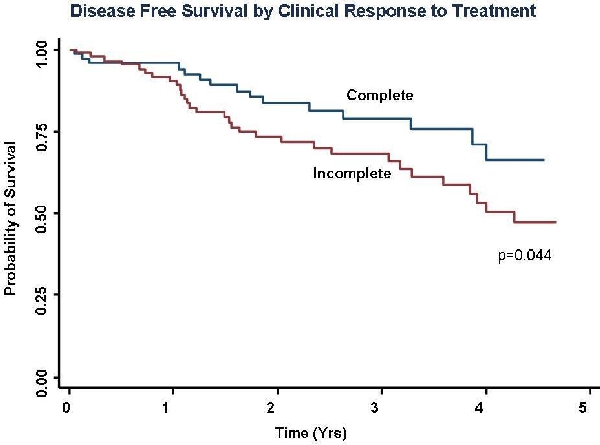Back to Program | 2010 Program and Abstracts Overview | 2010 Posters
Extent of Response of Rectal Cancer to Neoadjuvant Chemoradiation Predicts Outcome
Kelly M. Mclean*1,2, Jonathan M. Hernandez1,2, Jill Weber1, Farhaad C. Golkar2, Lauren Lange1, David Shibata1
1Gastrointestinal Oncology, H Lee Moffitt Cancer Center and Research Institute, Tampa, FL; 2Surgery, University of South Florida, Tampa, FL
Background: Combined modality chemoradiation therapy (CMT) administered prior to surgery is the preferred approach for locally advanced rectal cancer (RC). Reports conflict regarding the prognostic significance of degree of response to CMT. This study evaluates the association between extent of clinical and pathologic response and clinicopathologic variables and patient outcomes. Method: From 1998-2008, 157 patients with biopsy-proven Stage II and III RC received neoadjuvant 5-FU based chemotherapy and radiation followed by radical resection. Clinicopathologic and survival data were collected by retrospective review of an IRB-approved database. Comparisons were performed using Chi-squared, Fisher’s Exact Test or Student’s t-test. Survival analyses used the Kaplan-Meier method. Results: Our population consisted of 62 women and 95 men with a median age of 61 years (range 29-85) and a median follow up of 31.4 months (range 1-116). 70 patients (44%) demonstrated clinical complete response (clinCR) while 38 (27%) had a pathologic CR(pathCR). 38 of 70 (55%) clinCR and 15 of 87 (17%) clin partial response (clinPR) patients demonstrated pathCR. Patients with clinCR were more likely to have sphincter preservation (88% vs. 71%; p=0.01) and improved disease-free survival (DFS; p=0.04) compared to patients with clinPR. Degree of clin response did not impact overall survival (OS) or disease-specific survival (DSS). PathCR compared to pathPR showed a lower recurrence rate (5% vs. 22%; p=0.02) and, when adjusted for disease-specificity, improved DFS (p=0.03) and DSS (p=0.05). Conclusion: Our study confirms that pathCR of RC treated by CMT is associated with superior DFS and DSS as compared to pathPR. Although clinical response does not necessarily correlate with pathologic response, determination of clinCR has prognostic value associated with improved DFS and increased sphincter preservation.
Back to Program | 2010 Program and Abstracts Overview | 2010 Posters



